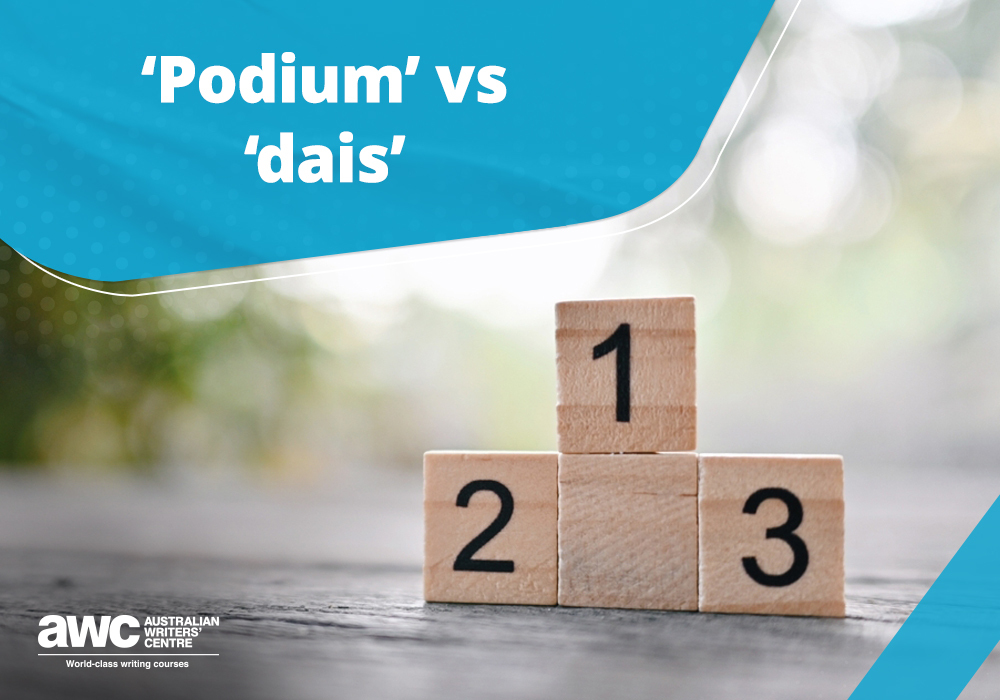Q&A: ‘Podium’ vs ‘dais’

Each week here at the Australian Writers’ Centre, we dissect and discuss, contort and retort, ask and gasp at the English language and all its rules, regulations and ridiculousness. It’s a celebration of language, masquerading as a passive-aggressive whinge about words and weirdness. This week, we're winning ways…
Q: Hi AWC, with the Olympics starting, we’re going to hear the word ‘podium’ a lot. But what’s the difference between a podium and a dais?
A: Good question, because while many think podiums are three-tiered by definition, that isn’t their definition at all.
Q: So what is it?
A: Macquarie Dictionary defines a “podium” simply as “a small platform”. This might be used by a conductor of an orchestra, a public speaker or yes, for recipients of awards.
Q: So just a raised platform?
A: Yep. It was first used in English in the 1740s – architecturally to describe a raised area around an arena where the VIPs sat, or later for the continuous base around a building. It’s from the Latin “podium” and Greek “podion” before that – meaning foot.
Q: Oh, like podiatry?
A: Exactly like that. It wasn’t actually until the 1940s that it got its most common meaning today as a raised structure at the front of a hall or stage.
Q: My uncle Thomas used to have the job of drilling podiums into the floor. For a while he was very worried that he was damaging the timber, but it turns out it was just a stage he was going through.
A: Groooan.
Q: So what about “dais” – how is that any different?
A: It’s certainly older – with “dais” arriving in English in the 1300s, as a “platform or raised floor at one end of a room or hall”. It came from Old French “dois” meaning high table, and Latin “discus” before that – where we also get the word “dish”. Curiously, according to the Online Etymology Dictionary, the word “dais” died out around 1600, only to be revived by the Scottish in the 1800s.
Q: Och aye!
A: If you want to find the biggest difference, a dais is sometimes considered a platform for many people, while a podium is fewer or just one. But then you have contradictory examples where a single throne sits upon a dais. They are very similar, except you’re more likely to call a raised circular structure a dais, especially knowing its lineage.
Q: And winners of medals in the discus at the Olympics really should stand upon a dais, not a podium!
A: Haha, sure. You will probably hear both terms – “medal dais” and “medal podium” – during the Olympics… they’re fairly synonymous at this point.
Q: Raised platforms, got it.
A: At this point, it’s probably a good idea to bring in a third word – “lectern”.
Q: Oh okay, what’s its deal?
A: Well typically, the lectern is the actual structure that a speaker might place notes on or which holds the microphone, pointer, water etc. It was traditionally the “reading desk in a church” – from the Latin word “lectrum”, meaning to read.
Q: So what’s that got to do with our raised platforms? Wouldn’t a lectern sit atop a dais or podium?
A: Well yes, but it’s worth mentioning that lecterns are increasingly being called podiums, especially in North American English.
Q: Ugh, I simply won’t stand for this!
A: Would you like a lectern?
Q: Hmmm. Okay, so let’s look at podiums in the Olympics. You mention they were part of ancient arenas, so I’m guessing they go waaay back.
A: Your guess is wrong.
Q: Of course it is.
A: A quick history lesson first. Basically, following the revival of the Modern Olympics in 1896, the whole medal ceremony was a hot mess. It wasn’t until 1928 that they had any kind of ceremony, with all the athletes receiving medals on the final day by marching up to a dignitary’s table and having the award bestowed upon them there.
Q: Sounds clunky.
A: It was. And it was actually at the first ever Empire Games (later becoming the Commonwealth Games) of 1930 that any kind of “podium” was first used. In that case, the winner stood on a raised middle step, while 2nd and 3rd stood lower down on either side. All three had a balcony style rail to lean on and from here they waved to the crowd, but never actually received medals while up there.
Q: So they literally put their top athletes on a pedestal.
A: They did. By the way, the figurative use of “to put someone on a pedestal” – as in to regard them highly – dates back to 1859.
Q: When did the Olympics first use podiums?
A: Ah yes. Well, the IOC President Count Henri de Baillet-Latour had been at those 1930 Empire Games and he liked what he saw. The podium would go on to make its debut in the 1932 Winter Games at Lake Placid and later that same year at the Los Angeles Summer Olympics.
Q: Wow, so the three-tiered thing like we have today?
A: Yep. In fact, that same guy made the rule that the 2nd place getter would stand on the winner’s right and the 3rd place getter on the left. And that’s how it has stayed – in the 2-1-3 order as you look at it.
Q: Very cool.
A: It was. And by the way, those Los Angeles games of 1932 were also the first to see the gold medalist have their national flag raised and anthem played at the podium presentation.
Q: So to recap, it could be called a winners’ dais or podium, as both mean raised platform, but “podium” seems to have become tied with the Olympics.
A: That’s right. In fact, especially in America, the word is often used as a verb. So “to podium” – much like “to medal” – would mean coming in 1st, 2nd or 3rd. Needless to say that purists aren’t all that impressed at this rise in “podiuming” – with even the New York Times writing about it back in 2010. But as we know, English is a living breathing language and you can’t meddle with progress.
Q: Unless you do that meddling on a “meddle” podium! See what I did there?
A: That’s not winning any gold…
Do you have a question you’d like us to explore? Email it to us today!
Browse posts by category
- Categories: Our famous Q&As!, Word lovers













